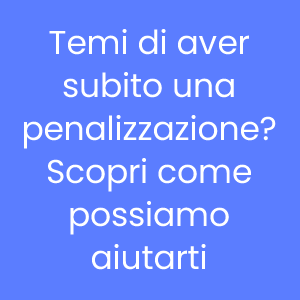Watch out for Google penalties: how to recognize them and recover
Paraphrasing a very well-known italian advertising campaign from the late 1980s, we can say “if you know them, you avoid them”: today our blog deals specifically with Google penalties, that is, the various sanctions that the search engine imposes to punish sites that have been guilty of behavior contrary to its quality guidelines, with first reference to the acquisition of backlinks or online spam activity. This penalty results in a dramatic drop in rankings and a loss of organic traffic, not to be confused with the other situations in which a site may run into a decrease in visibility.
What Google penalties are
The starting point is the guidelines for SEOs and webmasters, which have been called Search Essentials for a few years now, in which we read that there are “behaviors and tactics that can lead to lower rankings or complete removal from Google Search results,” which fall under the broader “Spam Rules.”
Wanting to summarize, this means that if (and when) Google discovers that a site has taken actions contrary to its guidelines it intervenes with a specific penalty, which can result in either lower rankings in the results or, in the worst cases, complete removal from the Search Engine Index as an effect – and in turn the penalty can be imposed on the individual page or, in the most severe and compromised situations, the entire site.
The work of detecting violating content and behavior is done both through automated systems and, if necessary, through review by individuals, ending in the execution of a manual action.
Techniques discouraged on the search engine
Google’s penalties spare no one: from small local businesses to large international brands, any website that breaks Google’s quality guidelines can be subject to penalties. It is important to note that Google does not act to punish, but to ensure that search results are as useful and relevant to users as possible.
In fact, the directions for creating a site in line with Google’s advice are really clear and simple, providing a few points to follow and adhere to:
- Design pages for users and not for search engines.
- Avoid misleading users
- Do not use tricks to improve ranking
- Find a way to make the site unique and valuable.
Then there is a detailed set of techniques that are openly discouraged as “illicit,” such as automatically generated content or content copied from other online resources, link schemes, cloaking or doorway pages, which we have already encountered in the in-depth study on black hat SEO and which represent, precisely, manipulative tactics that can result in a penalty from Google.
The types of Google penalties
In its official documentation, Google does not use the term “penalties” to refer to these anti-spam actions, which are instead referred to as manual actions, which (especially in the past) were accompanied by so-called “automatic actions” or “algorithmic actions.”
So these are the two major categories of penalties on the search engine, although in reality in almost all cases the “cleanup” is entrusted to the work of human specialists and there are no longer the penalties of the past, which were automatic and sudden.
Speaking of automatism, then, one should not confuse algorithmic penalties with the negative effects of Google’s algorithm updates: the changes brought about by broad core updates and the like are “re-calculations,” i.e., adjustments to SERP rankings generated by the search engine’s attempt to be ever more precise in responding to user requests and meeting its own quality standards.
Google’s algorithmic penalties
In this sense, sites that suffer declines in organic traffic and rankings in SERPs as a result of algorithm updates have not done something wrong, but have been rated less deserving than their competitors based on Google’s parameters, which as we know also exploits the hidden work of its quality raters (who are precisely the evaluators of the quality of search results provided by the engine, with useful indications for subsequent corrections of the system).
Manual actions, Google’s penalties to sites
So, currently the real Google penalties are the manual actions, the concrete sanctions that the Mountain View team imposes on a site that has been responsible for an established violation of the search engine’s guidelines. In fact, there is a division of specialists that deals precisely with individually reviewing sites and assigning penalties if irregular behavior is established, especially to continue the fight against spam, which remains a central problem on the Web.
Manual actions by the anti-spam team are initiated mainly in three circumstances: high spam risk on a resource, competition in popular, high-viewership SERPs and on sensitive topics (as in the case of YMYL topics), or as a consequence of spam reports from users to the search engine. However, it must be remembered that there are no automatic penalties after these reports, as John Mueller reminded us, and that (frequently) even spam sites can rank because Google also evaluates other factors.
How to find out if the site has been penalized
While a Google penalty is automatic and algorithm-based, manual actions are exactly what the name suggests: manual interventions by the Google team that occur when a human Google reviewer identifies a violation of quality guidelines that was not detected by the algorithms.
Manual actions can be more severe than algorithmic penalties and can result in the complete removal of a site from Google’s search results, but, another big difference, Google always provides notification of a manual action through the Google Search Console, giving the site owner a chance to fix the problem.
Generally speaking, however, the main way to figure out if the site has been penalized is to monitor its ranking and traffic, excluding factors such as downtime or technical SEO issues, to find out early on if there are any penalties in place.
As we said, since 2012 there has been a specific section in the Google Search Console, called Security and Manual Actions in which we can check for sanction actions on the site; if the site has been penalized, in fact, the owner or operator receives a message with which Google describes the problem.
The other way to find out if a site has suffered a penalty is to use Google Search: not finding even a URL previously placed among the results in SERP is a clue, which can be confirmed by searching with the advanced operator “site:”. If we do not find results, it means that Google has removed the site from its Index, reacting with the dreaded ban to the violation we were found guilty of.
Site penalization, does Google hit only the offending pages?
Generally, however, search engine penalties no longer focus on hitting the site in its entirety (except in exceptional cases), but rather on removing from the Index or collapsing the ranking of specific pages that have violated the rules and committed infractions.
How to avoid Google’s penalties
It is already clear from what has been written that the way to avoid running into penalization is simple: focus on quality, produce new, useful and original content, offer high levels of user experience and security, do not venture excessive off-page SEO tactics and look for risky backlinks. It is then no less important to focus on technical SEO aspects, implementing an optimized site structure that allows high performance even for mobile browsing.
In addition, it is important to regularly monitor the performance of our site through tools such as Google Search Console or SEOZoom, so that any problems that could lead to a penalty can be identified early.
Penalized website: how to get out of penalizations
If our website has been penalized, all is not lost. Even the most serious cases of penalization, in fact, may not be final: Google’s goal is to ensure that the web remains a place of quality and reliable information and that its SERPs are full of useful and valid results, and so the communication in Search Console is also a kind of invitation to solve the problems plaguing the site and to change behaviors, using the reconsideration request to ask for a reconsideration of the site after the cleanup actions.
The first step to recovery is then to identify and correct the violation that led to the penalty, directly addressing the problem that caused the penalty action. Once this is done, we can send a request for reconsideration to Google through Google Search Console itself.
Manual penalizations can thus be temporary, and a good fix can result in removal of the penalty, with recovery of Search positions and traffic. Obviously, it takes time and effort, because one must first read and understand the reason for the original penalty, study the strategy to address the problem and take action on the entire site (when the actions concern wide-site matches) or on the offending pages (partial matches), and then submit the request for reconsideration and hope that Google and its team will approve the effort and judge the site worthy of appearing in search results again.
It is obviously a different (and more challenging) job to diagnose the effect of an algorithmic adjustment, since we do not receive notifications from Google: although these penalties are rarer today, it is still important to check Google’s organic traffic and first see if the drop coincides with a known (or suspected, impacting other sites as well) algorithmic update or if it is instead a one-off case affecting our site.
The recovery process may take time and patience, but with a methodical approach and an unwavering commitment to quality, it is possible to bring our site back to visibility in Google’s search results by adhering to search engine guidelines and adopting an ethical SEO strategy.



